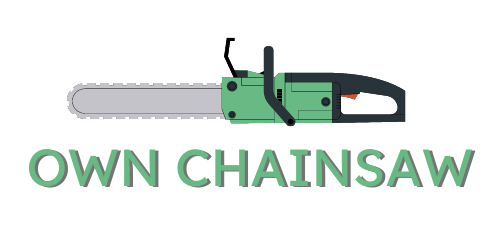Are you tired of battling with unruly trees and stubborn branches? It’s time to power up your lumberjack game with the ultimate chainsaw showdown: Top Handle vs Rear Handle!
These mighty tools will have you slicing through timber like a hot knife through butter. But which one is right for you?
Let’s dive into the nitty-gritty details. The Top Handle chainsaw is your go-to for precision and control. Perfect for climbing and maneuvering in tight spaces. Meanwhile, the Rear Handle chainsaw is a brute force to be reckoned with, designed for heavy-duty tasks and raw power.
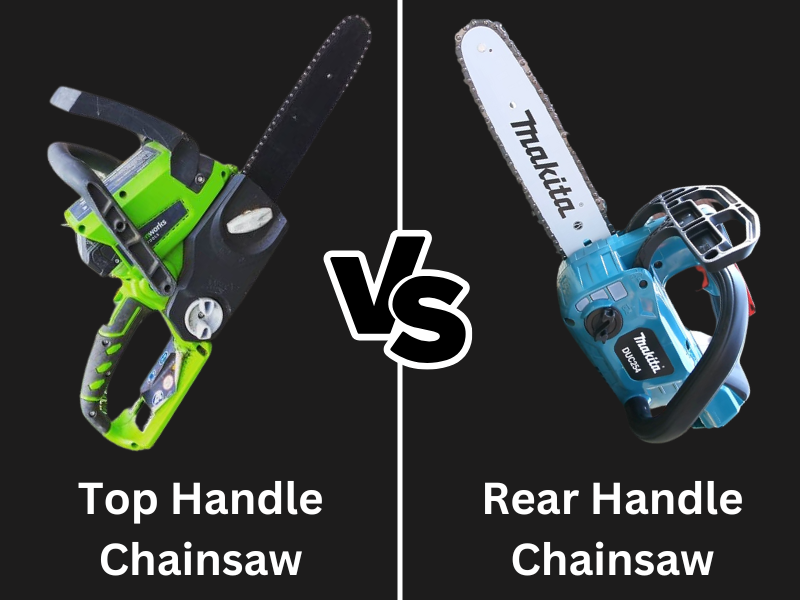
What is a Top Handle chainsaw?
Designed for one-handed operation, Top Handle chainsaws are compact and lightweight. Pruning and trimming branches require climbing or standing in elevated positions, which is why it’s designed for those tasks. It offers better maneuverability and control due to its handle positioned on top of the engine housing.
Its reduced size and weight make it an attractive choice among arborists and tree surgeons. A Top Handle chainsaw still packs a punch when it comes to cutting power and efficiency.
What is a Rear Handle chainsaw?
Two-handed rear handle chainsaws are robust and powerful chainsaws. It is built for heavy-duty tasks such as felling large trees, bucking logs, and cutting firewood. With its rear handle, the Rear Handle chainsaw offers greater control and stability when in use.
Weight distribution and ergonomic design reduce fatigue and increase safety. Individuals and professionals cutting wood of substantial size prefer chainsaws with rear handles.
Comparison between Top Handle and Rear Handle Chainsaws
Top Handle Chainsaws:
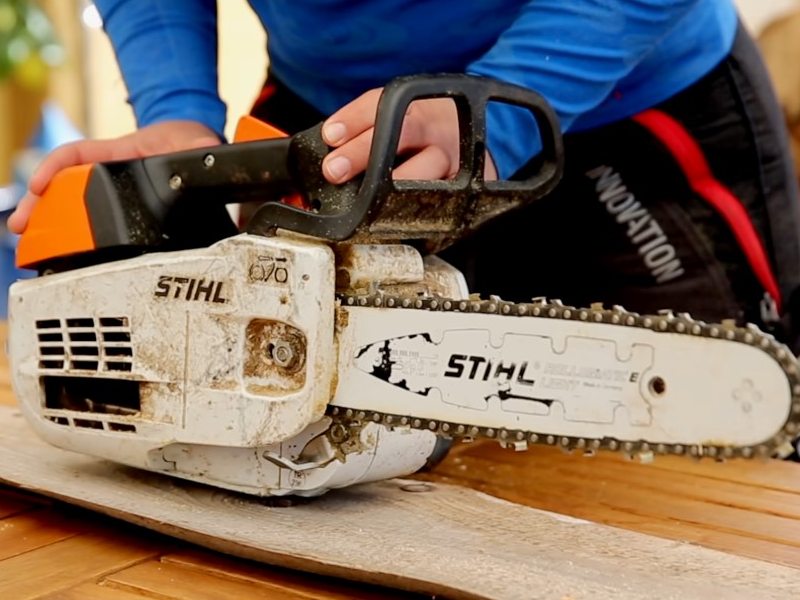
Top-handle chainsaws have a handle positioned on top of the cutting body. They offer several key advantages over rear-handle chainsaws
1. Maneuverability and Reach – Top-handle chainsaws are lightweight and compact, which makes them easy to maneuver. Their small stature allows users to easily navigate and operate them in elevated positions or tight spaces.
2. Power and Compactness – These chainsaws are known for their power and compactness. With their compact design, they are powerful tools that can handle demanding cutting tasks.
3. Ideal for Arborists – Top-handle chainsaws are particularly suited for professional arborists who need to make precise cuts. Their maneuverability and compactness enable arborists to work efficiently and safely in tree canopies.
4. Shorter and More Compact – Top-handle chainsaws are shorter and more compact compared to rear-handle chainsaws. In tight spaces or elevated positions, they are easier to handle because they lack a back handle.
Rear Handle Chainsaws:
On the other hand, rear-handle chainsaws have the handle positioned at the rear of the cutting body. They offer different features and advantages compared to top-handle chainsaws
1. Size and Weight – Rear-handle chainsaws are generally larger and heavier than top-handle chainsaws. For cutting through thick branches and logs, they provide the raw power needed for heavy-duty tasks.
2. Cutting Fallen Logs – Rear handle chainsaws are well-suited for sawing fallen logs on the ground. They’re larger and heavier, which allows them to cut through larger and heavier logs with better control and stability.
3. Handling and Ease of Use – Chainsaws with rear handles provide better handling and are generally easier to master. The handle at the rear offers a more traditional grip, allowing for comfortable and controlled operation.
Similarities between Top Handle and Rear Handle Chainsaws
Despite their differences, there are some similarities between top-handle and rear-handle chainsaws:
1. Wood Cutting Capability
Both types of chainsaws are designed to cut through wood and other materials. They are equipped with a chain and bar mechanism that efficiently cuts through the material being worked on.
2. Maintenance Requirements
Regular maintenance is essential for both top-handle and rear-handle chainsaws. This includes tasks such as sharpening the chain and keeping the bar properly lubricated.
3. Potential Danger
It’s important to note that both types of chainsaws can be dangerous if not used properly. Safe operation requires proper training, safety precautions, and adherence to manufacturer guidelines.
Cons of Top Handle and Rear Handle Chainsaws
Top Handle Chainsaws
1. Higher Cost – Top-handle chainsaws can be more expensive compared to rear-handle chainsaws in the same power class.
2. Potential Danger – Chainsaws handled improperly, especially at height, can result in accidents and injuries.
3. Limited Heavy-Duty Capability – Top-handle chainsaws are not suitable for cutting thick logs or branches. In such applications, their compact design and lower power may hinder their performance.
4. Increased Maintenance – Top-handle chainsaws require more frequent maintenance than rear-handle chainsaws. Their smaller oil reservoirs necessitate more frequent lubrication monitoring.
5. Higher Energy Requirement – Operating top-handle chainsaws can require more energy compared to rear-handle chainsaws. It will increase user fatigue and operating costs if top-handled models are used.
Rear Handle Chainsaws
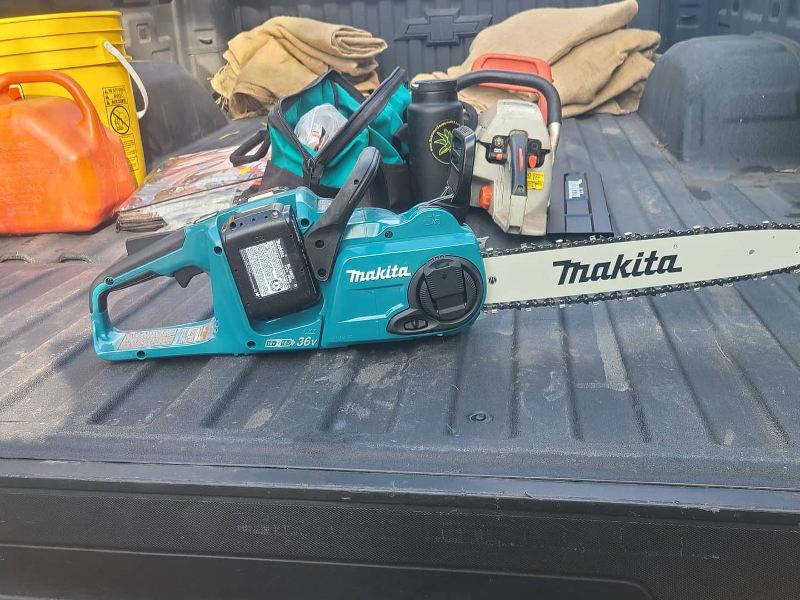
1. Maneuverability Challenges: Rear handle chainsaws can be more difficult to maneuver in tight spaces. As a result of their size and location at the rear, obstacles can be difficult to maneuver around.
2. Heavy and Cumbersome: Long-handled chainsaws tend to be more cumbersome. This added weight can contribute to user fatigue and potentially impact productivity.
3. Limited Suitability for Elevated Positions: Rear-handled chainsaws do not work well in elevated positions or for climbing trees. Above ground, rear-handle chainsaws provide less efficiency than front-handle chainsaws.
When should you use the top handle or rear handle chainsaw?
Chainsaws can be selected based on the specific requirements and circumstances of the task at hand. Here are some general guidelines on when to use each type:
Top Handle Chainsaws:
1. Elevated Positions – Chainsaws with top handles are ideal for working from ladders or climbing trees. For better precision and control, a smaller, more maneuverable vehicle is required.
2. Tight Spaces – Chainsaws with top handles make it easy to maneuver in tight spaces or manage dense vegetation.
3. Arborist Work – Arborists commonly use top-handle chainsaws to prune trees and trim branches. Using their compact design allows them to work at various angles with precision and control.
Rear Handle Chainsaws:
1. Heavy-Duty Tasks – Chainsaws with rear handles are superior when handling demanding jobs such as cutting through thick logs, felling large trees, or processing substantial amounts of wood. They are better equipped to handle high-impact tasks and provide more cutting force.
2. Ground Work – Rear handle chainsaws excel at cutting fallen logs on the ground due to their larger size and stability. They provide better balance and control when making horizontal cuts or working with heavier materials.
The choice between a top-handle and rear-handle chainsaw depends on several factors, including the job itself, accessibility, user expertise, and personal preference. The chainsaw type that provides the best performance and safety must be selected based on the task.
Can beginners use top-handle chainsaws?
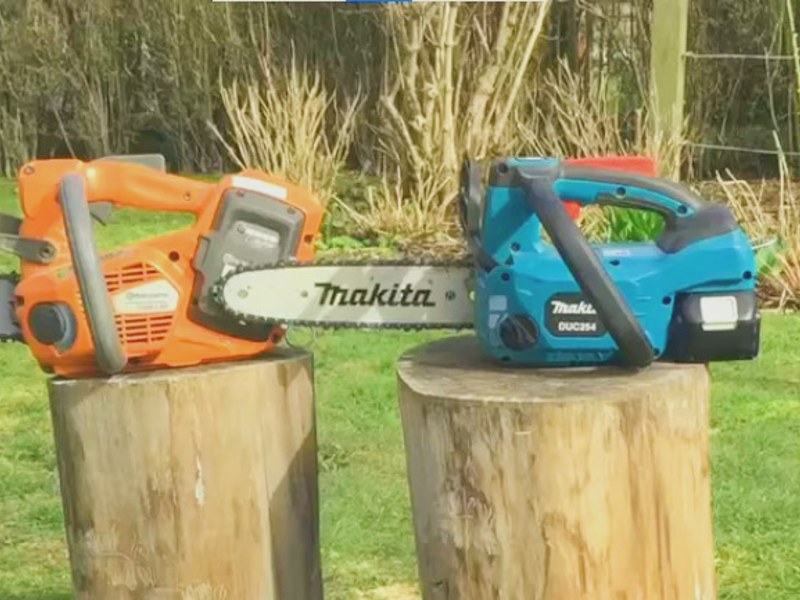
Top-handle chainsaws are generally not recommended for beginners or inexperienced users. These types of chainsaws require a higher level of skill, knowledge, and experience to handle safely and effectively. Here are a few reasons why beginners should exercise caution when considering a top-handle chainsaw:
1. Handling and Balance
Top-handle chainsaws have a different weight distribution compared to rear-handle chainsaws. The weight concentrated towards the front of the tool makes it more difficult for beginners to maintain control and balance.
2. Safety Concerns
Trees and ladders are often worked on using top-handle chainsaws. Working at heights requires a higher level of expertise and caution. Beginners are more likely to sustain injuries or accidents without proper training.
3. Limited Stability
Top-handle chainsaws sacrifice stability for their compact design. Beginners may make mistakes or lose control of the saw if stability is reduced.
4. Specialized Applications
Arborists trained in working safely at a height typically use top-handle chainsaws for tree-related tasks. These chainsaws are designed for precision cutting in challenging positions. A top-handle chainsaw may not be fully utilized by beginners due to a lack of skills or knowledge.
Conclusion
It is crucial to choose a chainsaw with top or rear handles for optimal performance. The right chainsaw can improve efficiency, safety, and effectiveness.
It offers better control and maneuverability when working at heights or in tight spaces. A rear-handle chainsaw, on the other hand, is better suited to larger, ground-based tasks.
If the wrong chainsaw is chosen, it can perform poorly, increase risks, and result in accidents. Before making a decision, it is imperative to carefully assess the job’s requirements.
FAQs
Can a top-handle chainsaw be used for ground-level cutting?
As per the guidelines provided by the Arboriculture and Forestry Advisory Group (AFAG), top-handled chainsaws are preferred for off-ground work; rear-handled saws are preferred for groundwork. Top-handle chainsaws are sometimes necessary, especially if they perform better or are perceived as safer. When positioned on the ground, workers can use top-handle chainsaws for pruning tasks.
Can I convert a top-handle chainsaw into a rear-handle chainsaw?
Converting a chainsaw with a top handle to one with a rear handle is not a recommended or practical option. Top-handle chainsaws and rear-handle chainsaws are designed differently to cater to specific purposes. Modifying a top-handle chainsaw requires adjusting the fuel and air intake systems and potentially exposing yourself to safety risks. Invest in a rear handle chainsaw that is specifically designed and manufactured for this purpose.
Which chainsaw is more suitable for home use or DIY projects?
Rear handle chainsaws are more suitable for home use or DIY projects. Larger and bulkier than top-handle chainsaws, they are better suited to heavy-duty tasks, such as chopping thick branches and logs. Rear-handle chainsaws are easier to handle and are a better choice for beginners.
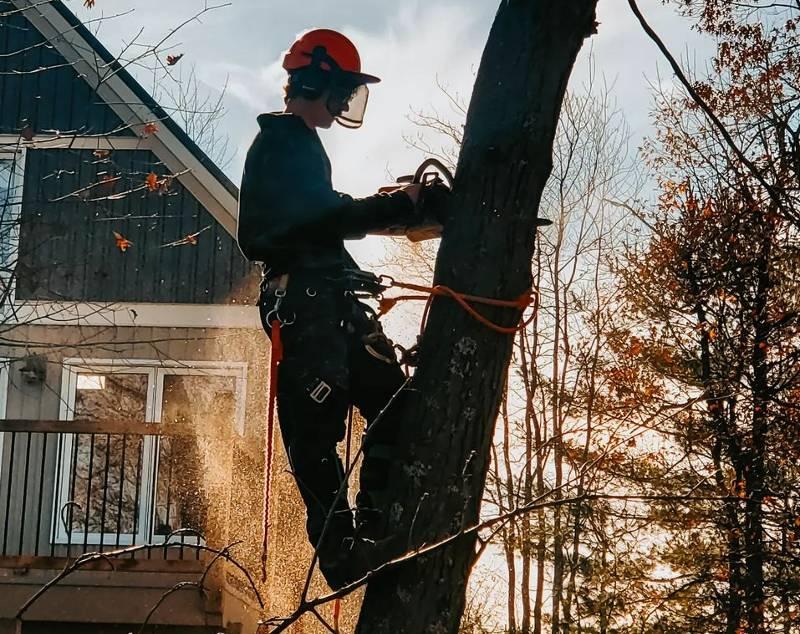
I am Senior Editor and CEO and I have been a chainsaw enthusiast for over 12 years. As a passionate chainsaw enthusiast, I have got a wealth of knowledge and experience with chainsaws, and I am constantly striving to expand my expertise and knowledge. Read More!
